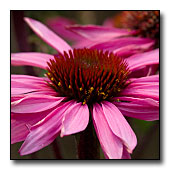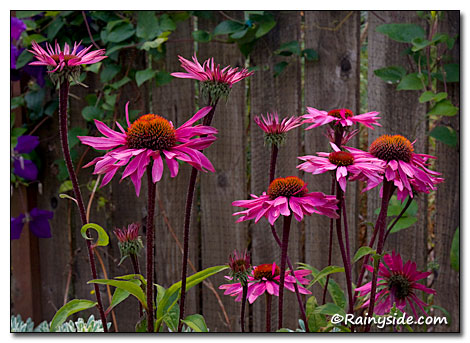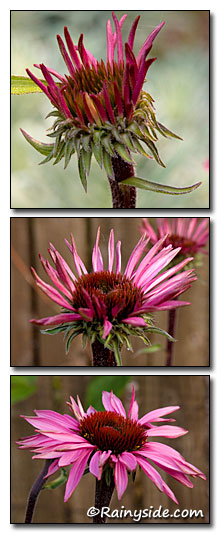Echinacea 'Merlot'
CONEFLOWER
Family: Asteraceae
Pronounced: ek-in-AY-see-ah

Quick Jumps
Growing Guide
Rainy Side Notes
GROWING GUIDE

Origin:
Garden.
Plant group:
Perennial.
Hardiness:
Sunset zones: A2, A3, 1-24.
USDA zones: 4-9.
Heat zones: 9-1.
Mature size:
Height: 24 inches (30 cm).
Width: 30 inches (76 cm).
Flowering period:
July through October.
Flowering attributes:
Fragrant, large 5-inch wide flowers with red-purple petals surrounding bronzy orange cones that sit on top of hairy, burgundy-black stems.
Leaf attributes:
Green, oblong leaves with serrated margins.
Growth habit:
Clumping, upright.
Light:
Full sun.
Soil:
Humus rich, well-drained soil.
Feeding:
Side dress with compost or manure. Fertilize in spring with a complete organic fertilizer.
Propagation methods:
Divide in autumn or spring.
Pruning Methods:
Dead head flowers for longer bloom period.
Pests and Diseases:
Leaf miners and occasionally powdery mildew and fungal leaf spots are a problem.
Rainy Side Notes

These excellent Echinaceas grow in a skinny garden that lines my driveway. They flower at the same time as a Clematis ‘Jackmanii’ that climbs up a fence right behind the coneflowers and I love the show! The photo above shows two plants blooming on their first year in the ground. As they settle in, Echinaceas will eventually be smothered with up to 35 huge blossoms per well-branched plant! The fragrant, red-purple flowers sit on top of burgundy-black stems (the color of merlot) that are so stout they won’t need staking. The cones are bronzy-orange, and as the flowers age the petals reflex slightly downward.
Although some sources rate this perennial as hardy down to USDA zone 3, other sources rate it only down to zone 6 or zone 5 with protection. A safe bet would be going with Terra Nova Nurseries who introduced this plant and rates it at zones 4-9. West of the Cascade Mountains in the Pacific Northwest, it is perfectly hardy for us—so grow away!
Reportedly, leaf miners, powdery mildew, and fungal leaf spots can be a problem; however, I have not seen this to be so on any of my echinaceas including this variety. Give them well-drained soil, divide every four years, and they should thrive for you.
These perennials are deer resistant, but other wildlife loves this plant. Butterflies and bees swarm the cones in search of nectar, and if you leave the cones on the plants to develop seeds, our goldfinches will make a feast of them. If you love birds in your garden, a flock of finches hanging out on the black cone heads is a sight to savor during the colder months of the year.
Echinacea comes from the Greek word echinos that refers to the prickly receptacle scales and purpurea means purple flower.
As with most echinaceas, this cultivar is a great choice for cut flowers. For fresh flowers, it is best to harvest when petals are expanding. Flowers last 7-10 days in a vase when a preservative is used. When harvesting only for the orange disk, allow the petals to mature before harvesting so the petals will be easy to remove. For drying purposes, remove petals and hang to dry.
Photographed in author's garden.

Gardening for the Homebrewer: Grow and Process Plants for Making Beer, Wine, Gruit, Cider, Perry, and More
By co-authors Debbie Teashon (Rainy Side Gardeners) and Wendy Tweton
Copyright Notice | Home | Search | Perennials

